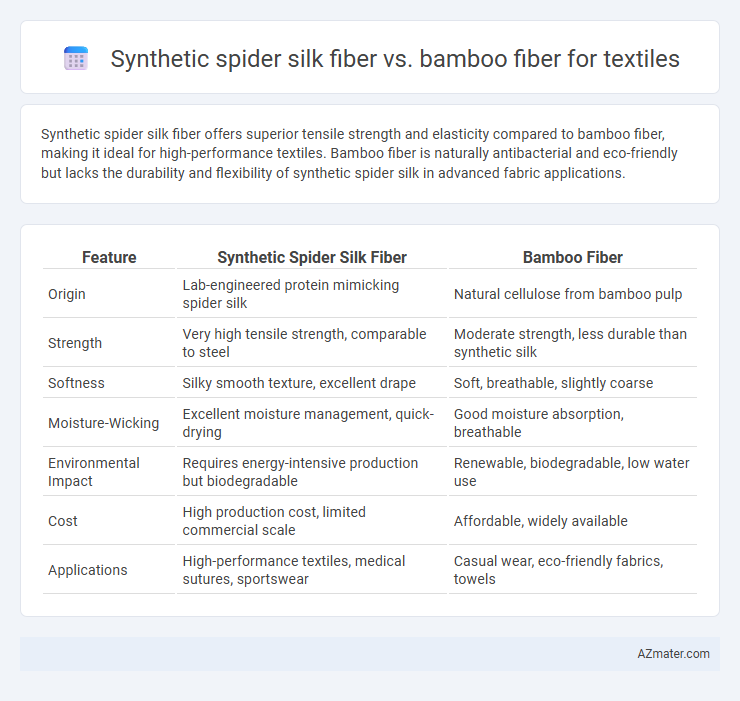Synthetic spider silk fiber offers superior tensile strength and elasticity compared to bamboo fiber, making it ideal for high-performance textiles. Bamboo fiber is naturally antibacterial and eco-friendly but lacks the durability and flexibility of synthetic spider silk in advanced fabric applications.
Table of Comparison
| Feature | Synthetic Spider Silk Fiber | Bamboo Fiber |
|---|---|---|
| Origin | Lab-engineered protein mimicking spider silk | Natural cellulose from bamboo pulp |
| Strength | Very high tensile strength, comparable to steel | Moderate strength, less durable than synthetic silk |
| Softness | Silky smooth texture, excellent drape | Soft, breathable, slightly coarse |
| Moisture-Wicking | Excellent moisture management, quick-drying | Good moisture absorption, breathable |
| Environmental Impact | Requires energy-intensive production but biodegradable | Renewable, biodegradable, low water use |
| Cost | High production cost, limited commercial scale | Affordable, widely available |
| Applications | High-performance textiles, medical sutures, sportswear | Casual wear, eco-friendly fabrics, towels |
Introduction to Synthetic Spider Silk and Bamboo Fiber
Synthetic spider silk fiber mimics the natural protein structure of spider silk, offering exceptional tensile strength, elasticity, and biodegradability, making it a revolutionary material in textile innovation. Bamboo fiber, derived from the cellulose of bamboo plants, is celebrated for its softness, breathability, and natural antibacterial properties, positioning it as a sustainable and eco-friendly option in fabric production. Both fibers contribute uniquely to the textile industry by combining performance with environmental benefits, driving advancements toward sustainable fashion solutions.
Overview of Fiber Production Processes
Synthetic spider silk fiber is produced through biotechnological methods involving genetically engineered microbes that spin fibroin proteins into fibers mimicking natural spider silk's strength and elasticity. Bamboo fiber extraction employs mechanical or chemical processes to transform bamboo pulp into viscose or rayon fibers, often requiring significant chemical treatment to achieve textile-grade softness. Synthetic spider silk fiber production emphasizes scalable precision and biomimicry, while bamboo fiber production centers on raw material renewability and chemical refinement techniques.
Material Structure and Molecular Composition
Synthetic spider silk fiber exhibits a highly organized beta-sheet crystalline structure formed by repetitive amino acid sequences such as glycine and alanine, which impart exceptional tensile strength and elasticity. In contrast, bamboo fiber primarily consists of cellulose, hemicellulose, and lignin, with a complex polysaccharide matrix that provides natural biodegradability and moisture absorption but lower mechanical strength. The molecular composition of synthetic spider silk allows for uniform fiber production with tailored mechanical properties, whereas bamboo fiber's heterogeneous cellulose structure yields variability in texture and durability for textile applications.
Mechanical Strength and Durability Comparison
Synthetic spider silk fiber exhibits superior mechanical strength with tensile strength up to 1.75 GPa, surpassing bamboo fiber's typical range of 0.3 to 0.5 GPa, making it ideal for high-performance textile applications. Its durability is enhanced by excellent elasticity and resistance to wear, whereas bamboo fiber, while biodegradable and breathable, tends to degrade faster under repeated stress and moisture exposure. The combination of synthetic spider silk's resilience and bamboo's eco-friendly properties offers distinct advantages depending on textile performance requirements.
Environmental Impact and Sustainability
Synthetic spider silk fiber offers exceptional strength and elasticity with a lower environmental footprint compared to traditional synthetic fibers, as it is often produced using bioengineered microorganisms that require less water and energy. Bamboo fiber is biodegradable and renewable, but its environmental impact varies greatly depending on the processing methods, with chemical treatments sometimes causing pollution and resource depletion. Overall, synthetic spider silk presents a more sustainable alternative by combining high-performance material properties with eco-friendly production practices, while bamboo fiber sustainability depends heavily on responsible sourcing and manufacturing.
Comfort and Wearability in Textiles
Synthetic spider silk fiber offers exceptional softness, breathability, and moisture-wicking properties, making it highly comfortable for prolonged wear in textiles. Bamboo fiber is naturally hypoallergenic, lightweight, and has excellent thermal regulation, providing a cool and breathable fabric ideal for sensitive skin. Compared to bamboo fiber, synthetic spider silk delivers superior tensile strength and elasticity, enhancing wearability without compromising comfort.
Biodegradability and End-of-Life Considerations
Synthetic spider silk fiber offers high strength and elasticity but poses challenges in biodegradability due to its protein-based yet engineered composition, which may require specialized conditions for effective decomposition. Bamboo fiber, derived from natural cellulose, exhibits superior biodegradability, breaking down efficiently in soil and reducing environmental impact during its end-of-life phase. Considering textile lifecycle, bamboo fiber aligns better with sustainable waste management practices, while synthetic spider silk demands advanced recycling or composting technologies to mitigate ecological concerns.
Applications in Modern Textile Industry
Synthetic spider silk fiber offers exceptional tensile strength and elasticity, making it ideal for performance textiles such as sportswear, medical sutures, and wearable technology, where durability and flexibility are critical. Bamboo fiber, valued for its natural antibacterial properties and biodegradability, is widely used in eco-friendly textiles like casual wear, towels, and bed linens, appealing to sustainable fashion markets. Both fibers contribute to innovation in the modern textile industry by catering to specialized functional requirements and environmental sustainability demands.
Cost and Scalability of Fiber Production
Synthetic spider silk fiber offers high tensile strength and elasticity but remains costly due to complex biotech manufacturing processes, limiting mass production scalability. Bamboo fiber, derived from rapidly renewable bamboo plants, provides a more cost-effective and scalable option with established industrial processing methods, enabling large-scale textile production. While synthetic spider silk promises superior performance, bamboo fiber currently dominates textile markets where affordability and production volume are critical.
Future Prospects and Innovations
Synthetic spider silk fiber offers remarkable tensile strength, elasticity, and biodegradability, positioning it as a revolutionary material for sustainable and high-performance textiles. Advances in bioengineering and recombinant DNA technology are driving scalable production, enabling innovations in lightweight, durable, and eco-friendly fabrics that outperform traditional bamboo fiber. Bamboo fiber, known for its softness and natural antibacterial properties, faces limitations in mechanical strength and environmental impact from chemical processing, prompting ongoing research to enhance its sustainability and integration with synthetic blends.

Infographic: Synthetic spider silk fiber vs Bamboo fiber for Textile
 azmater.com
azmater.com